Venn Diagrams
Purplemath
Venn diagrams were invented by a guy named John Venn (no kidding; that was really his name) as a way of picturing relationships between different groups of things. Inventing this type of diagram was, apparently, pretty much all John Venn ever accomplished. To add insult to injury, much of what we refer to as "Venn diagrams" are actually "Euler" diagrams. But we'll stick with the usual "Venn" terminology for the purposes of this lesson.
Since the mathematical term for "a group of things" is "a set", Venn diagrams can be used to illustrate set relationships.
Content Continues Below
To draw a Venn diagram, we first draw a rectangle which is called our "universe". In the context of Venn diagrams, the universe is not "everything in existence", but "everything that we're working with right now". Let's deal with the following list of things: moles, swans, rabid skunks, geese, worms, horses, Edmontosorum (a variety of duck-billed dinosaurs), platypodes (being more than one platypus), and a very fat cat.
(By the way, about the plural of "platypus": It is not "platypi". In Australian usage, the plural is often given as being "platypusses", but the technically-correct plural is "platypode". When platypode give birth, their babies are called "puggles".)
We'll call our universe "Animals", since every element in our set is some sort of animal:
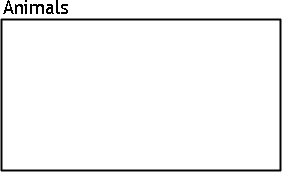
Let's say we want to classify things according to being small and furry or being a duck-bill. We draw circles inside our universe to display our classifications:
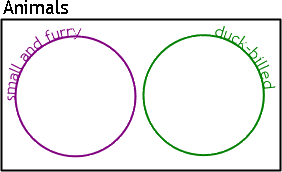
Now we'll fill in, or "populate", the diagram. Moles, rabid skunks, platypusses, and my (dear departed) very fat cat are all small and furry:
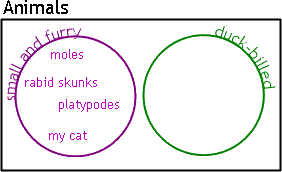
Swans, geese, platypodes, and Edmontosorum are all duck-bills:
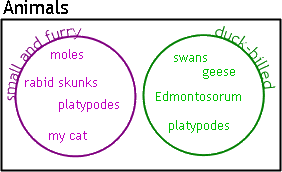
Worms are small but not furry, and horses are furry but not small, and neither is a duck-bill. However, they are some of the animals we're considering. This means that they fit inside our universe, but they're outside both of the circles.
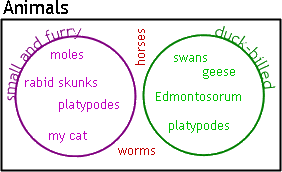
Notice that "platypodes" is listed in both of the circles. The point of Venn diagrams is that we can show this overlap in set membership by overlapping these circles.
Content Continues Below
In other words, we really should have drawn the circles overlapped, like this:
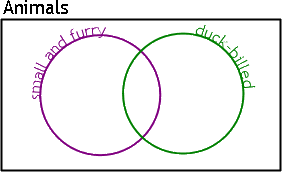
Now when we populate the Venn diagram, we'll only have to write "platypodes" once, in the overlap:
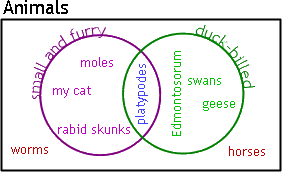
The overlap of the two circles, containing only "platypodes", is called the "intersection" of the two sets.
When drawing Venn diagrams, you will probably always be dealing with two or three overlapping circles, since having only one circle would be boring, and having four or more circles quickly becomes astonishingly complicated.
Venn diagrams have two general applications: explaining set notation, and doing a certain class of word problems. We'll first look at set notation....
URL: https://www.purplemath.com/modules/venndiag.htm
Select a Course Below
Standardized Test Prep
Homeschool Math
© 2024 Purplemath, Inc. All right reserved. Web Design by ![]()



